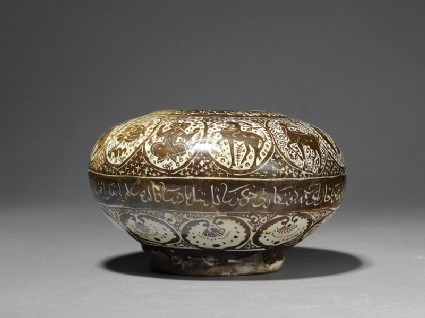Browse: 1240 objects
- Reference URL
Actions
Jar with epigraphic band and roundels enclosing the signs of the zodiac
-
Details
- Associated place
- Date
- early 13th century
- Material and technique
- fritware, with overglaze painting in lustre
- Dimensions
-
11.2 cm (height)
18.5 cm (diameter)
- Material index
- Technique index
- Object type index
- No. of items
- 1
- Credit line
- Presented by Sir Alan Barlow, 1956.
- Accession no.
- EA1956.58
-
Further reading
Allan, James W., Islamic Ceramics, Ashmolean-Christie's Handbooks (Oxford: Ashmolean Museum, 1991), no. 16 on p. 30, illus. pp. 30-31
Fehérvári, Géza, Islamic Pottery: A Comprehensive Study Based on the Barlow Collection (London: Faber and Faber, 1973), no. 102 on p. 92, pl. 45 a
Glossary (2)
fritware, lustre
-
fritware
Ceramic material composed of ground quartz and small quantities of clay and finely ground frit (frit is obtained by pouring molten glass into water).
-
lustre
Metallic sheen obtained by applying a mixture of metallic oxides onto an already glazed ceramic that is refired at a reduced atmosphere.
Location
Objects are sometimes moved to a different location. Our object location data is usually updated on a monthly basis. Contact the Jameel Study Centre if you are planning to visit the museum to see a particular object on display, or would like to arrange an appointment to see an object in our reserve collections.
Galleries
Publications online
-

Islamic Ceramics
On this second example of Kashan lustre, the influence of the book painting tradition is clearly to be seen. Astrological miniatures in roundels are known from extant medieval manuscripts, and the cross in reserve used as a background pattern for the roundels is derived from a similar design used in Quranic manuscripts as a background for script.
The sun and its symbolism have already been illustrated (no. 10 [EA1978.2311]). On this jar we find the twelve signs of the zodiac: (reading from left to right) Cancer, Gemini, Taurus, Aries, Pisces, Aquarius, Capricorn, Sagittarius, Scorpio, Libra, Virgo and Leo. From Capricorn to Libra are reconstructions, as that part of the vessel is largely missing. Of particular interest in an Islamic context is Virgo, who is shown here as a seated figure holding what is probably a handful of corn in her right hand, and a cutting implement in her left. The imagery stems from her Arabic name, al-sunbulat, which also means ‘an ear of corn’. Aquarius is normally shown drawing water from a well, but here the artist seems to have been satisfied with a very sketchy water bottle in the figure’s right hand.
Medieval Islamic society was clearly very superstitious. In European society today astrological superstition normally focuses on the zodiacal sign under which the individual was born, hence the mugs, key-rings and the like decorated with a single zodiacal image. In early Islam the birth sign of an individual was also significant. But the use of that specific image in an artistic context seems to have been unusual, and almost all surviving objects with zodical decoration bear the full range of twelve signs.
© 2013 University of Oxford - Ashmolean Museum











